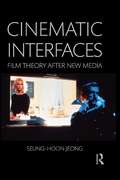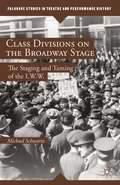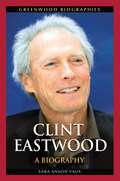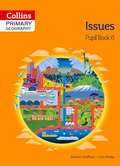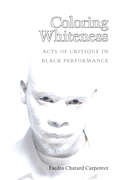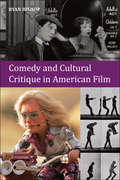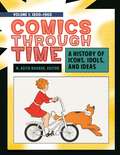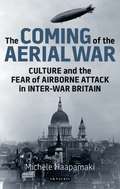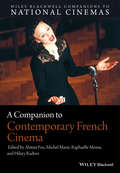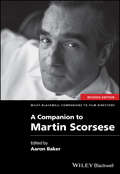- Table View
- List View
Cinematic Homecomings: Exile and Return in Transnational Cinema
by Rebecca PrimeThe history of cinema charts multiple histories of exile. From the German émigrés in 1930s Hollywood to today's Iranian filmmakers in Europe and the United States, these histories continue to exert a profound influence on the evolution of cinematic narratives and aesthetics. But while the effect of exile and diaspora on film practice has been fruitfully explored from both historical and contemporary perspectives, the issues raised by return, whether literal or metaphorical, have yet to be fully considered. Cinematic Homecomings expands upon existing studies of transnational cinema by addressing the questions raised by reverse migration and the return home in a variety of historical and national contexts, from postcolonialism to post-Communism. By looking beyond exile, the contributors offer a multidirectional perspective on the relationship between migration, mobility, and transnational cinema. 'Narratives of return' are among the most popular themes of the contemporary cinema of countries ranging from Morocco to Cuba to the Soviet Union. This speaks to both the sociocultural reality of reverse migration and to its significance on the imagination of the nation.
Cinematic Homecomings: Exile and Return in Transnational Cinema
by Rebecca PrimeThe history of cinema charts multiple histories of exile. From the German émigrés in 1930s Hollywood to today's Iranian filmmakers in Europe and the United States, these histories continue to exert a profound influence on the evolution of cinematic narratives and aesthetics. But while the effect of exile and diaspora on film practice has been fruitfully explored from both historical and contemporary perspectives, the issues raised by return, whether literal or metaphorical, have yet to be fully considered. Cinematic Homecomings expands upon existing studies of transnational cinema by addressing the questions raised by reverse migration and the return home in a variety of historical and national contexts, from postcolonialism to post-Communism. By looking beyond exile, the contributors offer a multidirectional perspective on the relationship between migration, mobility, and transnational cinema. 'Narratives of return' are among the most popular themes of the contemporary cinema of countries ranging from Morocco to Cuba to the Soviet Union. This speaks to both the sociocultural reality of reverse migration and to its significance on the imagination of the nation.
Cinematic Interfaces: Film Theory After New Media
by Seung-hoon JeongIn this book, Seung-hoon Jeong introduces the cinematic interface as a contact surface that mediates between image and subject, proposing that this mediation be understood not simply as transparent and efficient but rather as asymmetrical, ambivalent, immanent, and multidirectional. Jeong enlists the new media term "interface" to bring to film theory a synthetic notion of interfaciality as underlying the multifaceted nature of both the image and subjectivity. Drawing on a range of films, Jeong examines cinematic interfaces seen on screen and the spectator’s experience of them, including: the direct appearance of a camera/filmstrip/screen, the character’s bodily contact with such a medium-interface, the object’s surface and the subject’s face as "quasi-interface," and the image itself. Each of these case studies serves as a platform for remapping and revamping major concepts in film studies such as suture, embodiment, illusion, signification, and indexicality. Looking to such theories as the ontology of the image and the phenomenology of the body, this original theorization of the cinematic interface not only offers a conceptual framework for rethinking and re-linking film and media studies, but also suggests a general theory of the interface.
Cinematic Interfaces: Film Theory After New Media
by Seung-hoon JeongIn this book, Seung-hoon Jeong introduces the cinematic interface as a contact surface that mediates between image and subject, proposing that this mediation be understood not simply as transparent and efficient but rather as asymmetrical, ambivalent, immanent, and multidirectional. Jeong enlists the new media term "interface" to bring to film theory a synthetic notion of interfaciality as underlying the multifaceted nature of both the image and subjectivity. Drawing on a range of films, Jeong examines cinematic interfaces seen on screen and the spectator’s experience of them, including: the direct appearance of a camera/filmstrip/screen, the character’s bodily contact with such a medium-interface, the object’s surface and the subject’s face as "quasi-interface," and the image itself. Each of these case studies serves as a platform for remapping and revamping major concepts in film studies such as suture, embodiment, illusion, signification, and indexicality. Looking to such theories as the ontology of the image and the phenomenology of the body, this original theorization of the cinematic interface not only offers a conceptual framework for rethinking and re-linking film and media studies, but also suggests a general theory of the interface.
Cinematic Terror: A Global History of Terrorism on Film
by Tony ShawCinematic Terror takes a uniquely long view of filmmakers' depiction of terrorism, examining how cinema has been a site of intense conflict between paramilitaries, state authorities and censors for well over a century. In the process, it takes us on a journey from the first Age of Terror that helped trigger World War One to the Global War on Terror that divides countries and families today. Tony Shaw looks beyond Hollywood to pinpoint important trends in the ways that film industries across Europe, North and South America, Asia, Africa and the Middle East have defined terrorism down the decades. Drawing on a vast array of studio archives, government documentation, personal interviews and box office records, Shaw examines the mechanics of cinematic terrorism and challenges assumptions about the links between political violence and propaganda.
Cinematic Terror: A Global History of Terrorism on Film
by Tony ShawCinematic Terror takes a uniquely long view of filmmakers' depiction of terrorism, examining how cinema has been a site of intense conflict between paramilitaries, state authorities and censors for well over a century. In the process, it takes us on a journey from the first Age of Terror that helped trigger World War One to the Global War on Terror that divides countries and families today. Tony Shaw looks beyond Hollywood to pinpoint important trends in the ways that film industries across Europe, North and South America, Asia, Africa and the Middle East have defined terrorism down the decades. Drawing on a vast array of studio archives, government documentation, personal interviews and box office records, Shaw examines the mechanics of cinematic terrorism and challenges assumptions about the links between political violence and propaganda.
Class, Crime and International Film Noir: Globalizing America's Dark Art
by D. BroeClass, Crime and International Film Noir argues that, in its postwar, classical phase, this dark variant of the crime film was not just an American phenomenon. Rather, these seedy tales with their doomed heroes and heroines were popular all over the world including France, Britain, Italy and Japan.
Class Divisions on the Broadway Stage: The Staging and Taming of the I.W.W. (Palgrave Studies in Theatre and Performance History)
by M. SchwartzExamining twenty-five years of theatre history, this book covers the major plays that feature representations of the Industrial Workers of the World. American class movement and class divisions have long been reflected on the Broadway stage and here Michael Schwartz presents a fresh look at the conflict between labor and capital.
Classical Masculinity and the Spectacular Body on Film: The Mighty Sons of Hercules
by D. O'BrienThe muscle-bound male body is a perennial feature of classically-inflected action cinema. This book reassesses these films as a cinematic form, focusing on the depiction of heroic masculinity. In particular, Hercules in his many incarnations has greatly influenced popular cultural interpretations of manliness and the exaggerated male form.
Clint Eastwood: A Biography (Greenwood Biographies)
by Sara Anson Ph.D.Clint Eastwood—actor, director, composer, musician, and politician—is undeniably one of the most prolific and accomplished celebrities of the modern age. This book provides insights into Eastwood's life and entire career, from early television appearances to recent award-winning films.He established himself early in his acting career as "the strong silent type" and became known as the "actor's director." In a career that spans seven decades, Eastwood's work has been influential for multiple generations of film audiences as well as actors, directors, and producers. This biography investigates the man who made his characters' lines such as "Go ahead—make my day" and "Get off my lawn" unforgettable, and shows why his movie roles and the films he directed are honored, studied, quoted, and remembered.The book describes everything from Eastwood's formative years and early days as a struggling actor to his family and personal life to his lifelong love of jazz music and his political leanings. The chapters describe not only his tremendous accomplishments and countless successes but also his notable failures—coverage that will intrigue readers interested in the film industry, in the acting craft, and in enduring popular cultural icons.
Clint Eastwood: A Biography (Greenwood Biographies)
by Sara Anson Ph.D.Clint Eastwood—actor, director, composer, musician, and politician—is undeniably one of the most prolific and accomplished celebrities of the modern age. This book provides insights into Eastwood's life and entire career, from early television appearances to recent award-winning films.He established himself early in his acting career as "the strong silent type" and became known as the "actor's director." In a career that spans seven decades, Eastwood's work has been influential for multiple generations of film audiences as well as actors, directors, and producers. This biography investigates the man who made his characters' lines such as "Go ahead—make my day" and "Get off my lawn" unforgettable, and shows why his movie roles and the films he directed are honored, studied, quoted, and remembered.The book describes everything from Eastwood's formative years and early days as a struggling actor to his family and personal life to his lifelong love of jazz music and his political leanings. The chapters describe not only his tremendous accomplishments and countless successes but also his notable failures—coverage that will intrigue readers interested in the film industry, in the acting craft, and in enduring popular cultural icons.
Close Up: The Autobiography
by Kelly BrookFrom a council house in Kent to her first home in the Hollywood hills, from being told she was too big to model to becoming an inspiration for curvy girls everywhere, Kelly's life has taken many unexpected turns. As a child she just wanted to be an actress - she never imagined she'd also become a hugely popular pin up girl or that she'd be romanced by film stars and pursued by paparazzi.Now, in her deeply personal and honest autobiography, Kelly opens up about the men she has loved and the tragic loss and heartache she has overcome. And she reveals how, by refusing to be limited by other people's perceptions of her, she has forged a successful career as an actress, model and business woman. In Close Up we see the real Kelly. The girl behind the gloss. A funny, feisty woman who lives life on her own terms.
Cognitive Media Theory (AFI Film Readers)
by Ted Nannicelli Paul TaberhamAcross the academy, scholars are debating the question of what bearing scientific inquiry has upon the humanities. The latest addition to the AFI Film Readers series, Cognitive Media Theory takes up this question in the context of film and media studies. This collection of essays by internationally recognized researchers in film and media studies, psychology, and philosophy offers film and media scholars and advanced students an introduction to contemporary cognitive media theory—an approach to the study of diverse media forms and content that draws upon both the methods and explanations of the sciences and the humanities. Exploring topics that range from color perception to the moral appraisal of characters to our interactive engagement with videogames, Cognitive Media Theory showcases the richness and diversity of cognitivist research. This volume will be of interest not only to students and scholars of film and media, but to anyone interested in the possibility of a productive relationship between the sciences and humanities.
Cognitive Media Theory (AFI Film Readers)
by Ted Nannicelli Paul TaberhamAcross the academy, scholars are debating the question of what bearing scientific inquiry has upon the humanities. The latest addition to the AFI Film Readers series, Cognitive Media Theory takes up this question in the context of film and media studies. This collection of essays by internationally recognized researchers in film and media studies, psychology, and philosophy offers film and media scholars and advanced students an introduction to contemporary cognitive media theory—an approach to the study of diverse media forms and content that draws upon both the methods and explanations of the sciences and the humanities. Exploring topics that range from color perception to the moral appraisal of characters to our interactive engagement with videogames, Cognitive Media Theory showcases the richness and diversity of cognitivist research. This volume will be of interest not only to students and scholars of film and media, but to anyone interested in the possibility of a productive relationship between the sciences and humanities.
Collins Primary Geography: Pupil Book 6 Issues (PDF)
by Stephen Scoffham Colin BridgeCollins Primary Geography has been developed to provide full coverage of curriculum requirements for geography in the primary school. The four Key stage 2 primary geography books provide a progressive, skills-based scheme for the junior years. Each book is divided into units covering physical, human, and environmental geography. There are also case studies of contrasting localities in the UK, Europe, Asia, and the wider world. The pupil books use an extensive range of evidence to stimulate the children's interest and encourage investigative skills—photographs, maps, satellite images, artwork, charts, and diagrams. Each pupil book has an accompanying teacher's guide which contains copymasters.
Coloring Whiteness: Acts of Critique in Black Performance (Theater: Theory/Text/Performance)
by Faedra C CarpenterColoring Whiteness pays homage to the ways that African American artists and performers have interrogated tropes and mythologies of whiteness to reveal racial inequalities, focusing on comedy sketches, street theater, visual art, video, TV journalism, and voice-over work since 1964. By investigating enactments of whiteness—from the use of white makeup and suggestive masks, to literary motifs and cultural narratives regarding “white” characteristics and qualities—Faedra Chatard Carpenter explores how artists have challenged commonly held notions of racial identity. Through its layered study of expressive culture, her book considers how artistic and performance strategies are used to “color” whiteness and complicate blackness in our contemporary moment. Utilizing theories of performance and critical race studies, Coloring Whiteness is also propelled by Carpenter’s dramaturgical sensibilities. Her analysis of primary performance texts is informed not only by traditional print and visual materials, but also by her interviews with African American theater artists, visual artists, and cultural critics. The book is an invaluable contribution to the fields of theater and performance studies, African American studies, cultural studies, critical race studies, and American studies.
Comedy and Cultural Critique in American Film
by Ryan BishopThis book uses large scale social and cultural trends and major world events to analyse the American comedy film. This is a historical and conceptual study discussing the comedy narrative, comic traditions, and role of visual culture. The important innovators of American film comedy and the role of visual technology within cultural politic are discussed, as well as theorists such as Freud, Baudrillard, and Derrida. Key features* Close analysis of two films to illustrate key points in each chapter* Relevant both to film and cultural studies* Chronological treatment
The Comic Offense from Vaudeville to Contemporary Comedy: Larry David, Tina Fey, Stephen Colbert, and Dave Chappelle
by Rick DesRochersThe Comic Offense from Vaudeville to Contemporary Comedy examines how contemporary writer/performers are influenced by the comedic vaudevillians of the early 20th century. By tracing the history and legacy of the vaudeville era and performance acts, like the Marx Brothers and The Three Keatons, and moving through the silent and early sound films of the early 1930s, the author looks at how comic writer/performers continue to sell a brand of themselves as a form of social commentary in order to confront and dispel stereotypes of race, class, and gender. The first study to explore contemporary popular comic culture and its influence on American society from this unique perspective, Rick DesRochers analyzes stand-up and improvisational comedy writing/performing in the work of Larry David, Tina Fey, Stephen Colbert, and Dave Chappelle. He grounds these choices by examining their evolution as they developed signature characters and sketches for their respective shows Curb Your Enthusiasm, 30 Rock, The Colbert Report, and Chappelle's Show.
The Comic Offense from Vaudeville to Contemporary Comedy: Larry David, Tina Fey, Stephen Colbert, and Dave Chappelle
by Rick DesRochersThe Comic Offense from Vaudeville to Contemporary Comedy examines how contemporary writer/performers are influenced by the comedic vaudevillians of the early 20th century. By tracing the history and legacy of the vaudeville era and performance acts, like the Marx Brothers and The Three Keatons, and moving through the silent and early sound films of the early 1930s, the author looks at how comic writer/performers continue to sell a brand of themselves as a form of social commentary in order to confront and dispel stereotypes of race, class, and gender. The first study to explore contemporary popular comic culture and its influence on American society from this unique perspective, Rick DesRochers analyzes stand-up and improvisational comedy writing/performing in the work of Larry David, Tina Fey, Stephen Colbert, and Dave Chappelle. He grounds these choices by examining their evolution as they developed signature characters and sketches for their respective shows Curb Your Enthusiasm, 30 Rock, The Colbert Report, and Chappelle's Show.
Comics through Time [4 volumes]: A History of Icons, Idols, and Ideas [4 volumes]
by M. Keith BookerFocusing especially on American comic books and graphic novels from the 1930s to the present, this massive four-volume work provides a colorful yet authoritative source on the entire history of the comics medium.Comics and graphic novels have recently become big business, serving as the inspiration for blockbuster Hollywood movies such as the Iron Man series of films and the hit television drama The Walking Dead. But comics have been popular throughout the 20th century despite the significant effects of the restrictions of the Comics Code in place from the 1950s through 1970s, which prohibited the depiction of zombies and use of the word "horror," among many other rules. Comics through Time: A History of Icons, Idols, and Ideas provides students and general readers a one-stop resource for researching topics, genres, works, and artists of comic books, comic strips, and graphic novels. The comprehensive and broad coverage of this set is organized chronologically by volume. Volume 1 covers 1960 and earlier; Volume 2 covers 1960–1980; Volume 3 covers 1980–1995; and Volume 4 covers 1995 to the present. The chronological divisions give readers a sense of the evolution of comics within the larger contexts of American culture and history. The alphabetically arranged entries in each volume address topics such as comics publishing, characters, imprints, genres, themes, titles, artists, writers, and more. While special attention is paid to American comics, the entries also include coverage of British, Japanese, and European comics that have influenced illustrated storytelling of the United States or are of special interest to American readers.
The Coming of the Aerial War: Culture and the Fear of Airborne Attack in Inter-War Britain (International Library of Twentieth Century History)
by Michele HaapamäkiIn the first half of the 20th century the possibility of flight opened up entirely new avenues of thought and exploration. In the age of H.G. Wells and Biggles, the opening up of the air to balloons and planes - the Royal Flying Corps was founded in 1912 - appealed to concepts of courage and bravery which would be both encouraged and undermined by the experiences of World War I. The sky also held new terrors for everyday people who were now within reach of an airborne enemy - these fears included the possibilities of bombing, poison gas, surveillance and social control. This duality of fear and enthusiasm drove the Air Raid Precaution movement, while vocal elements in the press and in parliament called for radical plans to cope with apocalyptic scenarios. Here, Michele Haapamäki charts the history of flight and of war in the air in the early 20th century, addressing the key issues of interwar historiography such as patriotism, fear, masculinity and propaganda.
A Companion to Contemporary French Cinema (Wiley Blackwell Companions to National Cinemas)
by Alistair Fox Michel Marie Rapha Lle Moine Hilary RadnerA Companion to Contemporary French Cinema presents a comprehensive collection of original essays addressing all aspects of French cinema from 1990 to the present day. Features original contributions from top film scholars relating to all aspects of contemporary French cinema Includes new research on matters relating to the political economy of contemporary French cinema, developments in cinema policy, audience attendance, and the types, building, and renovation of theaters Utilizes groundbreaking research on cinema beyond the fiction film and the cinema-theater such as documentary, amateur, and digital filmmaking Contains an unusually large range of methodological approaches and perspectives, including those of genre, gender, auteur, industry, economic, star, postcolonial and psychoanalytic studies Includes essays by important French cinema scholars from France, the U.S., and New Zealand, many of whose work is here presented in English for the first time
A Companion to Contemporary French Cinema (Wiley Blackwell Companions to National Cinemas)
by Raphaëlle Moine Alistair Fox Michel Marie Hilary RadnerA Companion to Contemporary French Cinema presents a comprehensive collection of original essays addressing all aspects of French cinema from 1990 to the present day. Features original contributions from top film scholars relating to all aspects of contemporary French cinema Includes new research on matters relating to the political economy of contemporary French cinema, developments in cinema policy, audience attendance, and the types, building, and renovation of theaters Utilizes groundbreaking research on cinema beyond the fiction film and the cinema-theater such as documentary, amateur, and digital filmmaking Contains an unusually large range of methodological approaches and perspectives, including those of genre, gender, auteur, industry, economic, star, postcolonial and psychoanalytic studies Includes essays by important French cinema scholars from France, the U.S., and New Zealand, many of whose work is here presented in English for the first time
A Companion to Martin Scorsese (Wiley Blackwell Companions to Film Directors)
by Aaron BakerA Companion to Martin Scorsese is a comprehensive collection of original essays assessing the career of one of America’s most prominent contemporary filmmakers. Contains contributions from prominent scholars in North America and Europe that use a variety of analytic approaches Offers fresh interpretations of some of Scorsese’s most influential films, including Mean Streets, Taxi Driver, Raging Bull, Goodfellas, Gangs of New York, and Hugo Considers Scorsese's place within the history of American and world cinema; his work in relation to auteur theory; the use of popular music and various themes such as violence, ethnicity, religion, sexuality, gender, and race in his films, and more
A Companion to Martin Scorsese (Wiley Blackwell Companions to Film Directors)
by Aaron BakerA Companion to Martin Scorsese A Companion to Martin Scorsese“This valuable book brings the exceptional scale of Martin Scorsese’s film work into clear view. His achievements are monumental, and the essays collected in this work provide wonderfully detailed and vivid analyses of his oeuvre. A comprehensive study of the most exciting filmmaker working today.”Robert Burgoyne, University of St AndrewsA Companion to Martin Scorsese, Revised Edition is a comprehensive collection of original essays assessing the career of one of America’s most prominent contemporary filmmakers. The first reference work of its kind, this book contains contributions from influential scholars in North America and Europe. The essays use a variety of analytic approaches to study numerous aspects of Scorsese’s work, from his earliest films to his place within the history of American and world cinema. They consider his work in relation to auteur theory, the genres in which he has worked, his use of popular music, and his recent involvement with film preservation. Several of the essays offer fresh interpretations of some of Scorsese’s most influential films, including Mean Streets, Taxi Driver, Raging Bull, GoodFellas, Gangs of New York, Hugo, and The Irishman. Others take a broader approach and discuss the representation of violence, ethnicity, religion, sexuality, gender, race, and other themes across his work. With insights that will interest film scholars as well as movie enthusiasts, this is an important contribution to the scholarship of contemporary American cinema.

